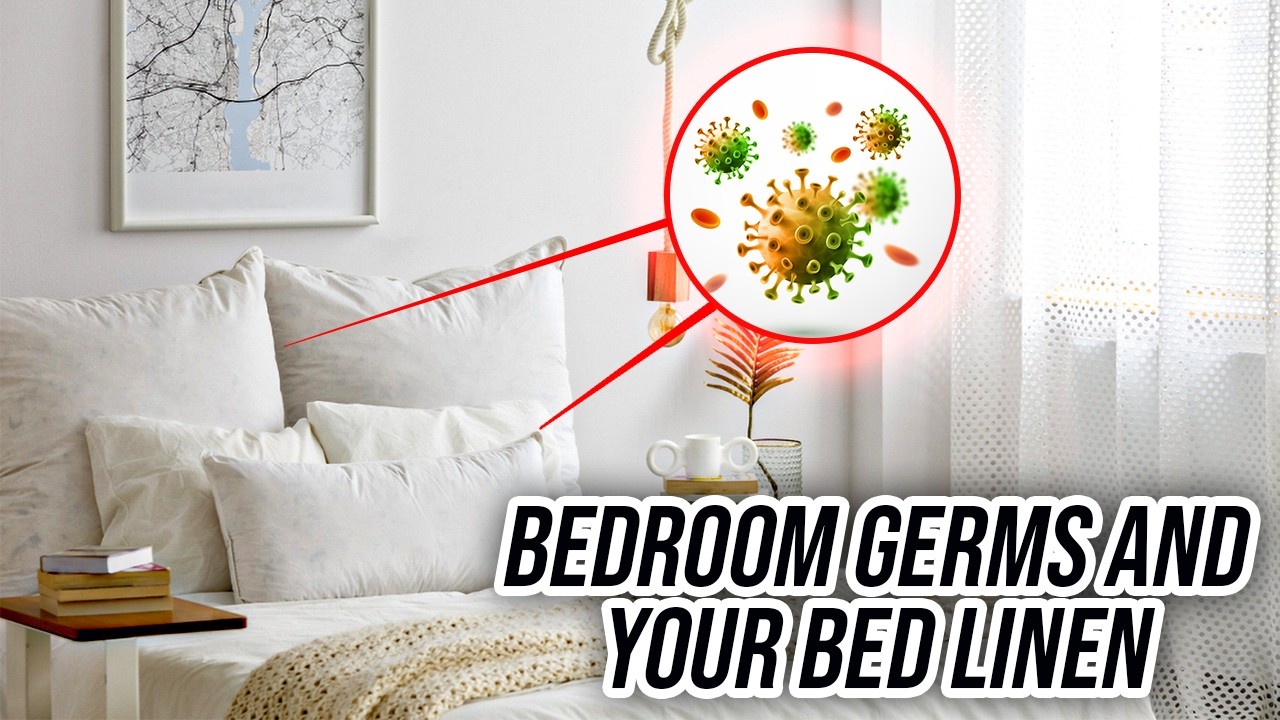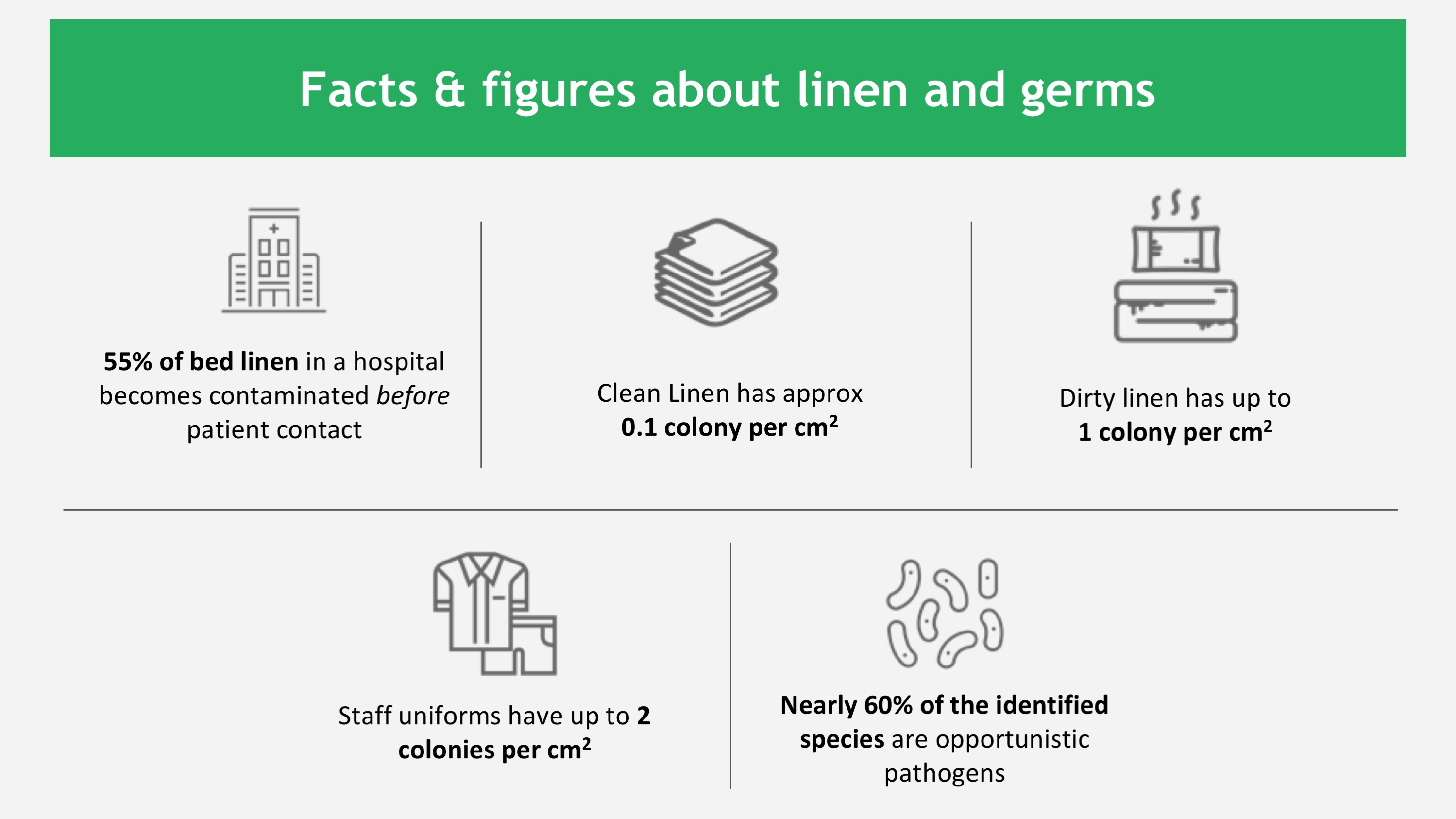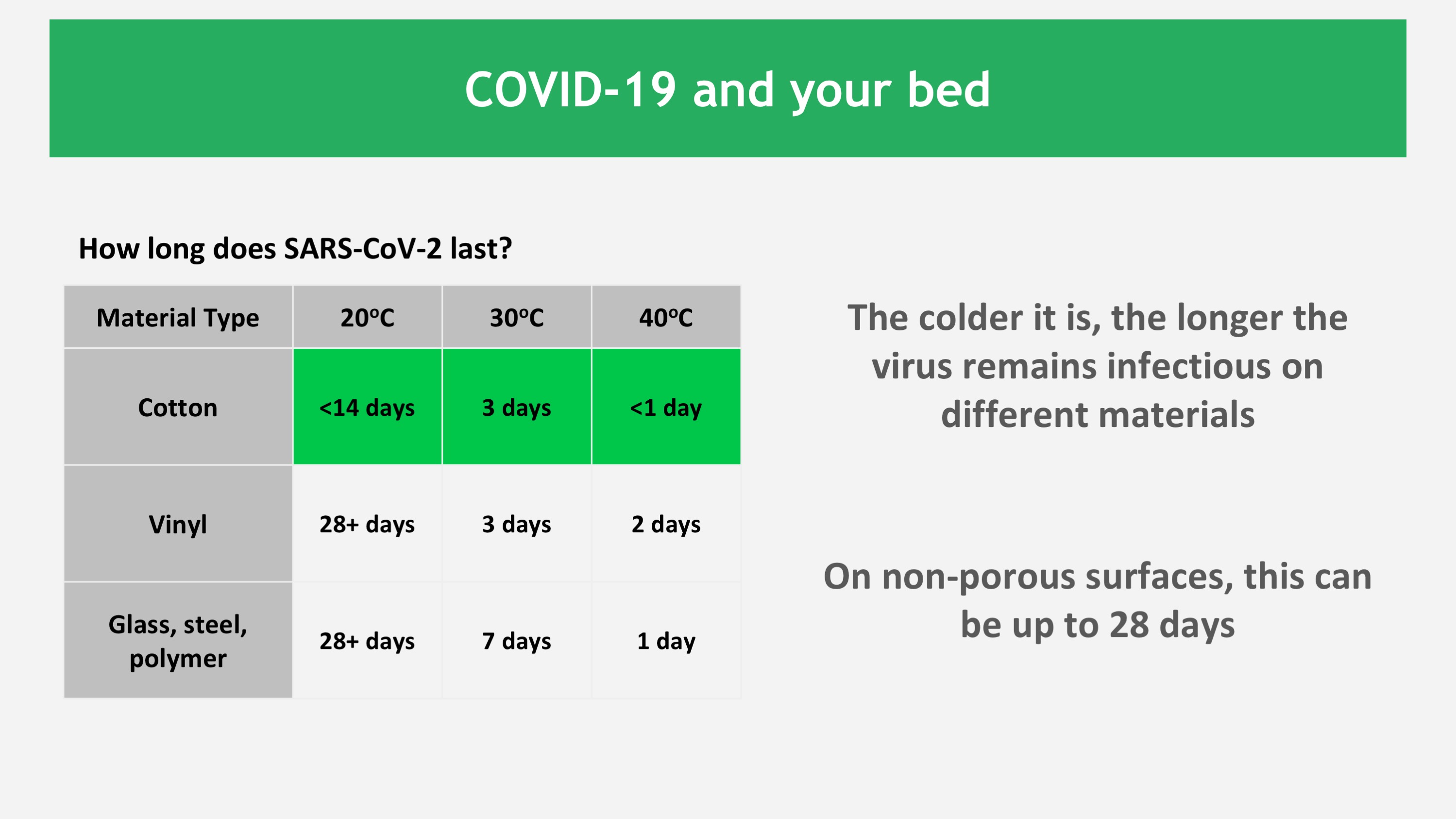Bedroom Germs and Your Bed Linen

Hi there. Thanks for joining me this week on The Mould Show. My name's Dr. Cameron Jones. I'm an environmental microbiologist. And this week we're going to be talking about an issue about the transmission of germs, and more specifically, the transmission of germs onto porous and semi-porous materials inside our bedrooms. Can you actually get sick from contact with your pillow? How best should you deal with cleaning your doona, your duvet? Maybe your bedhead is made of a porous material. What should you do? In any case, the topic that I'm talking about this week, the genesis of this actually came from Katherine Feeney, who is an ABC journalist and presenter at Radio Brisbane during her Afternoon show. And one of her listeners rang in and asked her a question, how often should you bathe? Is there a correlation with the transmission of germs into and out of the bedroom?
In any case, she rang me up, we had a lighthearted conversation on this earlier in the week, and I thought I would bring you some of the technical and scientific issues, which I didn't get a good chance to cover earlier in the week. And I thought many of you would be interested as well. We're also going to be talking about the viability of various different viruses, including SARS-CoV-2, as well as the influenza virus. So I think this is really important.
So without further ado, we will be talking about bedroom germs and your bed linen. And to get into this topic, I need to focus your attention on this surface hand to mouth or hand to mucous membrane issue, because this is the definition of what we term fomite transmission, and then is the transfer of germs onto surfaces and then from those surfaces onto our bodies.
And in many cases, this doesn't cause us any problems, but sometimes there are opportunistic pathogens, bacteria, yeast, fungi, and of course viruses, which can wreak havoc depending on your immune status and where and what type of infections they can actually cause. So we're going to be going into some of the research underpinning this.
And as I said, at the outset of this, we need to be focusing attention. What I want you to take home from this live stream is, how often should you wash your linens? How often should you wash yourself? And again, this issue of fomite transmission. It is 33% efficient when you touch an inanimate object and then bring it close to your mucous membrane. So think about that. One-third of the time you touch something, there is effective transfer onto yourself.

Now, this is a real big deal, because think of the consequences of transferring germs and obviously with the pandemic, we are all focusing attention. We all want to carry out effective infection control for ourselves and for the health and wellbeing of their family and friends. So anything that we can do to learn about how germs are transmitted and to minimize this is a good thing. But what does the research literature say?
So here's some facts and figures about linen and germs and disease transmission. Well, 55% of bed linen in a hospital becomes contaminated before the first patient makes contact with that bed. Now, how do we actually go about doing this? And I'm going to come back to these facts and figures here, but I just want to create a word picture here. Now, microbiologists like myself love Petri plates. Petri plates effectively are a way that you can culture out microbes. And we can use Petri plates to make direct contact with suspect surfaces like various different linens in bedrooms. And when scientists do these experiments in hospitals, they can get an understanding for the contamination level and that's what we want to work out.
So what is the contamination level on pillows and bedspreads and that sort of thing in the bedroom? And to work that out, you want to try to understand what the level of contamination is. And so essentially you work out what the number of colony-forming units are that you can see on the Petri plate, and then compare that to the surface area that you sampled or swabbed from or press plate affix the plate to. And what the research shows is that clean linen has approximately one-10th of a viable microorganism per square centimeter. Whereas dirty linen can have up to one viable colony per square centimeter, whereas staff uniforms and other clothing textiles can have up to two colonies per square centimeter.

And remember that nearly 60% of the species which were identified using these tests were what are known as opportunistic pathogens, meaning that they differ from wild-type environmental pathogens in that they are connected with known diseases or illnesses or infections. 60%, that's a high percentage. But is there another factor that we need to consider when we were talking about fear about contamination, fear about social distancing, for example, and what are the other behaviors around fears about contagion?
Well, this comes down to the hygiene hypothesis and a lot of fundamental philosophy of science, which is considering how we actually feel about disease and illness and our relationship to the microbial or the invisible world. And some really great research has just come out published in July 2021, which has been focusing on this topic because of course, with the pandemic, public health officials, public health scientists, and microbiologists were all interested in how communication occurs and communication effectively into society. And is there a potential connection with various different psychologies or personality types?
And guess what? The scientists have in fact discovered that there is a personality connection with fear about disease and illness. I'm going to show this to you now. And the fear of contamination is most acute in people that are classified as a type D personality. That is someone who is more likely to be distressed.

And this particular infographic I've put up is probably not doing justice to the complex psychological underpinnings of how you classify people's responses, but type A people are essentially driven. B people are more thoughtful and type C people are calm.
Whereas those people that show a distressed personality are more likely to have an innate response or fear around disease transmission. And we need to be aware of this because this is something real, and it definitely impacts on our understanding of disease transmission, but let's move away from fear of contamination. And let's look at some specific effects and figures concerning potentially, or probably the worst infection that none of us want to come in contact with certainly in 2020, 2021, and probably into the foreseeable future regarding coronavirus disease illness.
How long does SARS-COVID two last? Why are we even interested in this? Well, anyone who is asymptomatic or showing symptoms is probably shedding the virus into their porous and semi-porous bedding materials. Now, if those individuals are also showering and other members of the family are sharing those towels, that could be a way in which other family members are becoming cross-contaminated. And so when we considering virus coming into contact with exposure to virus or coming into contact with mold, for example, which is what I do most of my professional career, looking at water damage exposure and mold contamination and the impact on immune-compromised to people who are exposed to these environmental toxins, it's the same type of conversation.
What is the dose dependence? How did the individual become contaminated? What is the probability of this cross-contaminating to other individuals? And we have to look at some great research that came out by CSIRO and they have done some very good research with viable COVID. And they determined that there was a temperature connection or correlation with the recovery of viable virus. And this is really important, because we know from this, that the colder it is, the longer the virus remains infectious on different materials. And so on cotton, you will have a 20 degrees Celsius. It will last for about 14 days, 13 to 14 days. At 30 degrees Celsius, it will last for three days, whereas at 40 degrees Celsius, it will last for only up to one day. So remember that on non-porous surfaces like glass, steel or polymer banknotes, the virus can last up to 28 days.

Now, this is really concerning, but also really interesting, because if we know that it is possible to deactivate the SARS-COVID virus, then we're able to optimize those conditions that we wash our bed linen and sheets in. And there's some wonderful research again in the peer-reviewed literature, which has been looking at the temperature that you should set your washing machine at for a whole range of different microbes, your standard bacterial opportunistic pathogens, as well as different types of yeast, candida and what we know about the SARS-COVID two virus is that if we are able to use a hotter washing cycle and wash those clothes for longer, then we have a greater probability of reducing the microbial population that remains viable on these textiles.
And again, I'm going to put up the references to all of this, for this podcast and this live stream underneath in the show notes afterwards. But the take-home message is that always use a hotter wash cycle. And if you are decided to use the cold water cycle, then you're going to need to wash those clothes for a long period of time. In any case, what are some other tips and tricks that I would recommend? Well, frequent hand-washing and not sharing towels is something that all households should adopt.
We need to reduce the moisture indoors. And when I was talking to Katherine, we were talking about why it might be a good idea not to make your bed in the morning. And there's some good scientific evidence for why not, because we want to reduce the moisture indoors and maintain this as close to a 50% relative humidity. You want to air out your bed. And the best way to facilitate evaporation is to leave it unmade. But there is some also fantastic research as well that's come out about the SARS-COVID two virus showing that sunlight also deactivates and makes the virus less transmissible. And again, those references are going to be in the show notes, but I encourage you to read this because it's really quite exciting research.

So obviously use a mattress protector, use some sort of protector on your pillow and consider changing your pillow. Again, we have to acknowledge that the fear of illness is true. There are certain personality types that are going to be more susceptible to have concerns about fears about illness, but by the same token, we are living through a pandemic. And whilst we're in this situation, we need to take active steps to minimize our exposure to not just the virus, but also to other microbes that could impact on our immune status.
In any case, my name's Dr. Cameron Jones. I hope you've enjoyed this live stream. You'll find this on The Mould Show podcast on iTunes. If you've enjoyed it, please like this social media post wherever you're seeing it, share it with your friends, give it a thumbs up and I shall see you next week. Bye for now.
Watch the Livestream Video on YT:
REFERENCES:
Karamanou M, Panayiotakopoulos G, Tsoucalas G, Kousoulis AA, Androutsos G. From miasmas to germs: a historical approach to theories of infectious disease transmission. Infez Med. 2012 Mar;20(1):58-62. PMID: 22475662.
A. Pinon, J. Gachet, V. Alexandre, S. Decherf and M. Vialette, "Microbiological Contamination of Bed Linen and Staff Uniforms in a Hospital," Advances in Microbiology, Vol. 3 No. 7, 2013, pp. 515-519. doi: 10.4236/aim.2013.37069.
Tuman TC. The effect of type D personality on anxiety, depression and fear of COVID-19 disease in healthcare workers. Arch Environ Occup Health. 2021 Jul 15:1-8. doi: 10.1080/19338244.2021.1952152. Epub ahead of print. PMID: 34264179.
Widders, A., Broom, A., & Broom, J. (2020). SARS-CoV-2: The viral shedding vs infectivity dilemma. Infection, disease & health, 25(3), 210–215. https://doi.org/10.1016/j.idh.2020.05.002
Oxford, John & Berezin, Eitan & Courvalin, Patrice & Dwyer, Dominic & Exner, Martin & Jana, Laura & Kaku, Mitsuo & Lee, Christopher & Letlape, Kgosi & Low, Donald & Madani, Tariq & Rubino, Joseph & Saini, Narendra & Schoub, Barry & Signorelli, Carlo & Tierno, Philip & Zhong, Xuhui. (2014). The survival of influenza A(H1N1)pdm09 virus on 4 household surfaces. American Journal of Infection Control. 42. 423–425. 10.1016/j.ajic.2013.10.016.
Riddell, S., Goldie, S., Hill, A. et al. The effect of temperature on persistence of SARS-CoV-2 on common surfaces. Virol J 17, 145 (2020). https://doi.org/10.1186/s12985-020-01418-7
Broadhead, R., Craeye, L., & Callewaert, C. (2021). The Future of Functional Clothing for an Improved Skin and Textile Microbiome Relationship. Microorganisms, 9(6), 1192. https://doi.org/10.3390/microorganisms9061192

